October 21
"We are waiting for the long-promised invasion..... so are the fishes.” –WC
“...Security can only be obtained by a scheme by which the nations of Europe and outside agree together that all will guarantee each and each will guarantee all. The purposes of the war will be achieved if there is a League of Nations with an absolute and decisive veto upon any mere aggression, and consideration of any legitimate claims which any of the countries engaged in the War may be able to make good. Go back to the old Liberal tradition and trust yourself boldly to those decent, kindly, humane forces to be found in every man and every nation...” October 21


“...In the fall of 1918 the Great War in Europe was winding down and peace was on the horizon. The Americans had joined in the fight, bringing the Allies closer to victory against the Germans. Deep within the trenches these men lived through some of the most brutal conditions of life, which it seemed could not be any worse. Then, in pockets across the globe, something erupted that seemed as benign as the common cold. The influenza of that season, however, was far more than a cold. In the two years that this scourge ravaged the earth, a fifth of the world's population was infected. The flu was most deadly for people ages 20 to 40. This pattern of morbidity was unusual for influenza which is usually a killer of the elderly and young children. It infected 28% of all Americans (Tice). An estimated 675,000 Americans died of influenza during the pandemic, ten times as many as in the world war. Of the U.S. soldiers who died in Europe, half of them fell to the influenza virus and not to the enemy (Deseret News). An estimated 43,000 servicemen mobilized for WWI died of influenza (Crosby). 1918 would go down as unforgettable year of suffering and death and yet of peace...” October 21
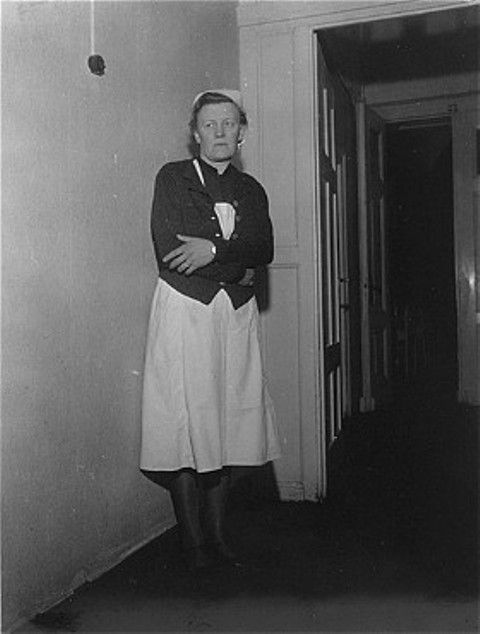
Irmgard Huber, chief nurse at Hadamar Institute, poses in the corridor of the euthanasia facility
“...The first "euthanasia" questionnaires are distributed to [German] mental hospitals. They are completed, in their capacity as "experts," by Professors Heyde, Mauz, Nitsche, Panse, Pohlisch, Reisch, C. Schneider, Villinger, and Zucker, all of whom are professors of psychiatry, and thirty-nine other doctors of medicine. Their payment is 5 pfennigs per questionnaire when more than 3,500 are processed per month, and up to 10 pfennigs when there are less than 500. A cross signifies death. There are 283,000 questionnaires to be processed. These experts mark at least 75,000 with a cross...” October 21


“...With Yugoslavian resistance collapsing, King Peter removed to London, setting up a government-in-exile. Hitler then began to carve up Yugoslavia into puppet states, primarily divided along ethnic lines, hoping to win the loyalty of some-such as the Croats-with the promise of a postwar independent state. (In fact, many Croats did fight alongside the Germans in its battle against the Soviet Union.) Hungary, Bulgaria, and Italy all took bites out of Yugoslavia, as Serb resisters were regularly massacred. On October 21, in Kragujevac, 2,300 men and boys were murdered; Kraljevo saw 7,000 more killed by German troops, and in the region of Macva, 6,000 men, women, and children were murdered...” October 21
Cynthia Southern Auschwitz Daily (@cmsouthern) 10/20/1944: 110 girls remain after the selection in the barracks for youths in the transit camp.
Today's Comic: Jimmy Fallon: “President Obama just appointed someone named Ron Klain as the new “Ebola czar” to oversee the government’s response to the crisis. You know that’ll be a tough job, but not as tough as introducing yourself as the Ebola czar and extending your hand.”
Today's Insult: "Time magazine today released a list of the 25 most influential teenagers. When they heard they made it on the list, every teenager had the same response: "What's a magazine?" You know who is on this most influential teenager list? Kim Kardashian's younger sisters. They've been very influential. They've influenced a lot of people to change the channel.” –Craig Ferguson
Twitter: @3rdReichStudies
Note: Images may or may not accurately represent the item adjacent to them. Also, please note that there is much, much, MUCH more detail available-and many, many, MANY more items as well-every day on the linked What Happened Today page. For the full story behind the events of this day, click the October 21 link. Really, October 21. Seriously, the October 21 link is the one to click. That's right, this one: October 21
Disclaimer: The selected Quotes, Jokes and Cartoons may or may not represent the views of the compiler of these daily posts. If they give you something to think about, they will have accomplished their task. Levi Bookin, Copy Editor, in particular bears no responsibility for any of them. He does, however, do a truly admirable job on the linked Daily pages, which everyone should peruse on a daily basis. It is WELL worth the small effort required. The Trick is to Click-> October 21
Dov Feigin, Sculpture in the Garden, 1982, Independence Park, Tel Aviv-Yafo
Buky Schwartz, Capital, Isracard Building, Tel Aviv-Yafo

From Hitler and the Holocaust, by Robert S. Wistrich: Mass murder on this scale could not have happened without the trial run, beginning in 1939, of the Nazi "euthanasia" program. The physicians of the Reich collaborated grossly in using poison gas and lethal injections to murder eighty thousand mentally and physically handicapped Germans. This so-called Operation T-4 (named for the central office at 4 Tiergarten Strasse, Berlin) had been personally ordered by Hitler. As Henry Friedlander has pointed out, "The success of the euthanasia policy convinced the Nazi leadership that mass murder was technically feasible, that ordinary men and women were willing to kill large numbers of innocent human beings, and that the bureaucracy would cooperate in such an unprecedented enterprise." The same sinister methods that were used in Operation T-4 to mask the killing of the handicapped would be applied in the Nazi death camps. SS guards would be dressed in the white uniforms of medical technicians, and the victims were always led to believe that they were being taken to a shower room rather than to a gas chamber.
The German perpetrators who staffed the machinery of destruction, whether in offices or in the camps, were "not a special kind of German" but rather "a remarkable cross section of the German population." Engaged in a vast murder operation, officially shrouded in secrecy, they appeared to be immune from any pangs of conscience. A vocabulary of euphemisms like "evacuation" or "special treatment" shielded them from any guilty feelings or doubts about the justice of their enterprise.
Hans Mommsen has persuasively argued that the use of bureaucratic and technocratic methods repressed any moral inhibitions among the perpetrators, turning the death of Jews into a technical problem of killing capacity. His view of the Holocaust is that it was essentially a rationalized, quasi-automatic process in which the extermination of those "unfit for work" developed a dynamic of its own: "The bureaucratic machinery created by Eichmann and Heydrich functioned more or less automatically; it was thus symptomatic that Eichmann consciously circumvented Himmler's order, at the end of 1944, to stop the Final Solution. There was no need for external ideological impulses to keep the process of extermination going."
But the machinery of death did not exist in an ideological void. Even a model bureaucrat like Eichmann—though no fanatical anti-Semite—displayed extraordinary zeal in hunting down Jews. His constant complaints about obstacles in the fulfillment of death-camp quotas, his impatience with the existence of loopholes such as the free zone in Vichy France, or the uncooperativeness of the Italians and other German allies in expediting the rounding up of Jews were not merely driven by a petty bureaucrat's desire to prove his efficiency. Eichmann was a convinced Nazi who rejoiced in the slaughter of Jews. The perpetrators—bureaucrats like Eichmann, modernizing technocrats, planners, and professional people—fitted themselves effortlessly into the prevailing genocidal ethos because they believed in what they were doing. Their motives were not always identical to those of the top Nazi decision makers, but there is every reason to think that they internalized the institutionalized anti-Semitism of the Nazi regime. It is most unlikely that they would have implemented mass murder against any arbitrarily designated enemy group.
The so-called functionalist school of historians has long argued that the "Final Solution" was not the product of any grand design but that the Nazi regime was administered by "a maze of competing power groups and rival bureaucracies" seeking the favor of a distant Fuehrer. In their view, such lack of coordination and fragmentation of decision making led to a "cumulative radicalization" of policies, each more arbitrary, violent, and radical in their implementation than its predecessors. The Nazis, it has been said, had no specific plan to "solve the Jewish question" in 1933 and simply drifted step by step down a very twisted road to Auschwitz-Birkenau. Even the annihilations, according to Martin Broszat, had a largely improvisatory character and did not derive from a specific Hitler order or from a clear "will to exterminate" but rather from a series of local Nazi initiatives aimed at solving local problems (food supply, logistical difficulties, and so on) on the eastern front. For Broszat, the Nazis had to find "a way out of a blind alley" into which they had maneuvered themselves. Once the practice of liquidation was established, it gained predominance and eventually evolved in an ad hoc manner into a comprehensive program that was subsequently approved by Hitler.' This seems plausible enough until one recalls that throughout the history of Nazi Germany, Hitler pursued a modus operandi of deliberate incitement against the Jews while leaving the execution of the policy to subordinates.
Moreover, some functionalist theories tend (perhaps unintentionally) to normalize Nazism by suggesting that its leaders stumbled into the most extreme criminal behavior. They unconvincingly turn Hitler himself into a weak, indecisive, procrastinating leader whose visionary political perspectives on the "Jewish question" had only a minor impact on the practical policy of genocide. The functionalists also downplay the ancient hatred of Jews, its transformation into "scientific" racism, the status, testimony, and suffering of the Jews themselves as a social and national group, the role of bystanders (individuals as well as states), not to mention the ideological motivations and mentality of the perpetrators.
More recent German scholarship has sought to go beyond the earlier abstract debates on "modernity" and the clash between intentionalists (who believe in the centrality of Hitler and a coordinated decision to murder the Jews of Europe) and skeptical functionalists. Ulrich Herbert, for example, while adopting the theory of "cumulative radicalization" and stressing the role of bureaucracy, does not assume that local decisions—whether in Serbia, Lithuania, or Byelorussia—were made outside a context of deeply ingrained anti-Semitism. He believes that the Holocaust was not simply the result of directives from Berlin but of an interaction between the center and an increasingly radicalized periphery." The empirical studies of Dieter Pohl and Thomas Sandkiihler, discussing the General Government and Galicia, highlight the importance of the periphery and the pivotal role of the civil administration in pushing vigorously for a radical anti-Jewish policy. This kind of research into the complex local political process in the German-occupied territories is certainly welcome; unfortunately, some of it tends to blur the decisive role of Hitler, Himmler, and others in Berlin in initiating, centralizing, and unifying the multitude of regional actions that were all part of a much larger and comprehensive "Final Solution." There are other weaknesses in this new trend in scholarship: the voice of the Jewish victims is rarely heard, and there is a tendency to overstate the symmetry between the Holocaust and the "ethnic cleansing" of other groups (especially Slavs) in eastern Europe. Only the Gypsies, as we have shown, offer a serious point of comparison, though their role in Nazi ideology was minimal.
Herbert, like Goldhagen before him, emphasizes both the numbers of the perpetrators involved (more than was previously assumed) and the fact that the murders were frequently carried out in a traditional, even "archaic" way. Much of the Nazi genocide, he reminds us, is not adequately described by the notion of factory-style killing, a so-called clean death by gassing, or the quasi-anonymous process of the German bureaucracy. The massacres of Jews in Lithuania, Poland, and the Balkans as well as the killings by Wehrmacht soldiers and the Einsatzgruppen on the eastern front support this point.
The "hot-blooded" slaughters and "Jew hunts" carried out by Order Police battalions in occupied Poland (described by Christopher Browning and Daniel Goldhagen) present us with a distinctly un-modern side of the Holocaust, one that aligns it more closely with other twentieth-century genocides. No high technology was required for the 40 percent of Holocaust victims who died through malnutrition, famine, and disease in the ghettos, through being worked to death in labor camps, through deportations late in the war that turned into horrific death marches, or through the gruesome executions in pits, trenches, and ravines, using machine guns, rifles, and revolvers. There was nothing particularly modern or civilized about such genocidal acts, any more than there is about those since 1945 in Cambodia, Rwanda, Bosnia, and other "backward" parts of the world. No spectacular industrial measures were needed for this purpose. Yet the moral lesson of the concentration and death camps in particular suggests that what Europe witnessed in the middle of the twentieth century was nonetheless something unprecedented: not so much in the statistics of the dead but in the devilish scale of the sufferings inflicted on the victims and the depravity of their tormentors.

Igael Tumarkin, Holocaust and Resurrection, 1975, Ibn Gabirol 69, Tel Aviv-Yafo
 Note: The content on this page changes regularly.
Note: The content on this page changes regularly.
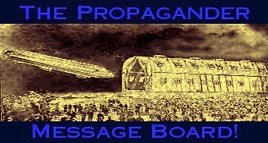





Featured Sites:
Adolf Hitler: Mein Kampf Examined

Disclaimer: The Propagander!™ includes diverse and controversial materials--such as excerpts from the writings of racists and anti-Semites--so that its readers can learn the nature and extent of hate and anti-Semitic discourse. It is our sincere belief that only the informed citizen can prevail over the ignorance of Racialist "thought." Far from approving these writings, The Propagander!™ condemns racism in all of its forms and manifestations.
Fair Use Notice: The Propagander!™may contain copyrighted material the use of which has not always been specifically authorized by the copyright owner. We are making such material available in our efforts to advance understanding of historical, political, human rights, economic, democracy, scientific, environmental, and social justice issues, etc. We believe this constitutes a "fair use" of any such copyrighted material as provided for in section 107 of the US Copyright Law. In accordance with Title 17 U.S.C. Section 107, the material on this site is distributed without profit to those who have expressed a prior interest in receiving the included information for research and educational purposes. If you wish to use copyrighted material from this site for purposes of your own that go beyond 'fair use', you must obtain permission from the copyright owner.


Click to join 3rdReichStudies






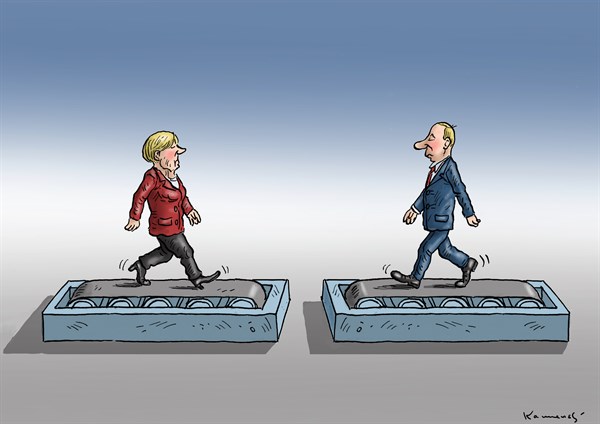
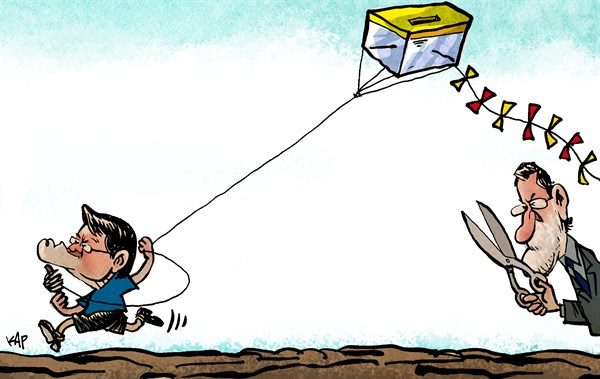



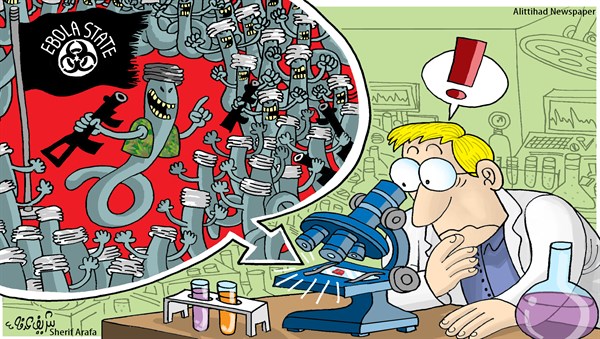























Note: The content on this page changes regularly.







